Managing Wildlife Populations
Wildlife Response–Bats: District Wildlife Biologist Jeffreys responded to two different calls from concerned members of the public regarding bats in need. These kinds of calls are typical for this time of year as the breeding season winds down and young, inexperienced pups are now on their own in the world, learning how to be a bat, and sometimes finding themselves in unsafe situations.
The first call was from an employee at a local business who was concerned for the safety of a bat (one of the Myotis species) clinging to a wall just a couple of inches above the ground. Not only was this bat easily within reach of any passing predator, but it was also just a few inches away from the office front door and near a lot of pedestrian traffic. This is a good example of a young bat that doesn’t quite understand how to find a suitable day roosting location where it will be safely tucked away from predators and insulated from the heat of the day. Luckily, this employee cared for the bat’s wellbeing but also knew to never attempt to handle a bat herself. Biologist Jeffreys drove out to the business, donned gloves, and gently removed the bat pup from the wall, placed it in a shoebox, and transported it to some trees across the street. Once there, Biologist Jeffreys removed the bat from the shoebox and placed it about six feet up in the fork of a shady tree, where it could crawl under some bark, and wait out the day before taking off again at night to catch some tasty bugs.
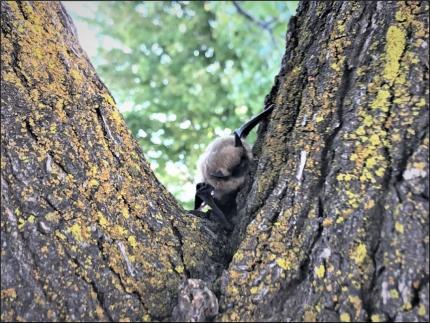
The second call regarding a bat in trouble came from a homeowner who was horrified to find a bat (also a Myotis sp.) stuck to a glue trap she had placed outside to kill wasps. Unfortunately, this disturbing event is all too common. Thousands of bats, birds, lizards, and other wildlife (even house cats on large board-style glue traps) die slow, excruciating deaths every year after coming into contact with sticky fly paper or a glue trap and not being able to free themselves. Please NEVER use glue traps or fly strips. Consider wildlife-safe and pet-safe alternatives, such as reusable hanging traps with small entrances that hornets or wasps crawl into to get at a protein or sugar source inside. These kinds of traps have the added benefit of not using any toxic chemicals such as those found in sticky traps.
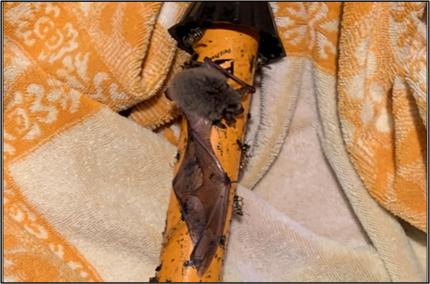
Biologist Jeffreys was able to carefully remove the bat from the sticky trap and, after many rounds of washing off and rinsing out most the remaining glue, the bat began vocalizing and getting more mobile again. However, his wings were still too sticky to allow him to fly, and a bat that can’t fly and catch bugs on the wing is a dead bat. So, Biologist Jeffreys and the very helpful and compassionate homeowner realized more help was needed and called a bat rehabilitator on the west side, who agreed to take the bat pup in for further treatment.
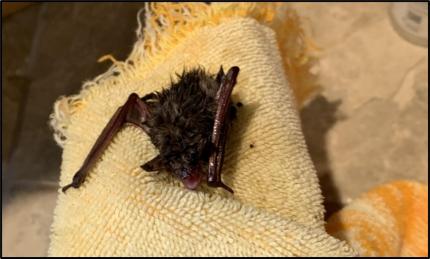
Fortunately for this little bat, the homeowner was heading to the west side the next day and was all too happy to drive up to Bothell and drop him off. The pup is currently in the care of this bat rehabber now, and she reported that he has a healthy appetite and is doing well. He is not out of the woods yet, and it’s possible he may have ingested some of the highly toxic glue, but let’s hope this little guy will make a full recovery and be flying the night sky again soon!
Wildlife Population Monitoring – Planning and Coordination
Mule Deer: Biologists Jeffreys and Eilers met with WDFW Ungulate Specialist Bundick to discuss ways to improve mule deer population surveys and monitoring in both the East Slope Cascades herd and the Columbia Plateau herd. Now that analysis has been completed, for three years of GPS data transmitted by collared does captured in 2020, biologists have learned that Highway 2 serves as a barrier between deer populations that is rarely crossed. The deer on either side exhibit spatially distinct patterns of home range and migration. This means that what has always been categorized as the Chelan subherd is actually comprised of two separate populations: one consisting of deer that winter in the Wenatchee Foothills region of Chelan and Kittitas counties (now known as the Wenatchee Mountains subherd), and one consisting of deer that winter north of Hwy 2 and south of Lake Chelan (the Chelan subherd). To monitor deer populations more accurately in District 7, biologists are working to redesign abundance and ratio surveys to reflect these new findings. For winter 2023, biologists plan to reallocate sampling units for aerial surveys as well as distribute more than 20 game cameras across known high-use migration corridors used by the Wenatchee Mountains subherd.
Mountain Goats: Biologist Jeffreys continued working with Ungulate Specialist Moore, State Wildlife Veterinarian Mansfield, and partners at U. S. Forest service and National Park Service to coordinate winter 2023-2024 capture and collaring efforts for mountain goats in the Lake Chelan Basin. This is a highly challenging project to coordinate due to the extremely rugged and inaccessible terrain as well as multiple, different land jurisdictions, much of it federally designated wilderness. Biologists are eager to make it happen this winter after only being able to collar two goats in January 2023 instead of the intended twenty. Both herds in the Lake Chelan Basin have been decreasing in number for years, and biologists are striving to learn more about these herds and the factors contributing to their decline.
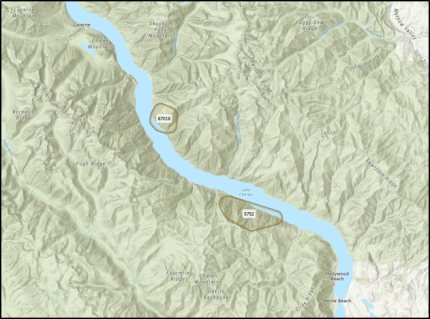
Fisher Surveys: Biologist Jeffreys continued planning and coordination efforts for upcoming fisher survey work. The fisher (Pekania pennanti) is a State Endangered, house cat-sized, member of the mustelid family that was once common throughout Washington but was extirpated by the mid-1900’s due to over-trapping, incidental human-caused mortality, and habitat loss. Following an initial fisher reintroduction effort in the Olympic Peninsula from 2008 to 2012, WDFW and other partners such as National Park Service (NPS), U.S. Fish and Wildlife (USFW), and Conservation Northwest reintroduced fishers to the Cascade Mountain Range from 2015 to 2020. Since then, fishers have dispersed from the reintroduction sites, created home ranges in historically occupied fisher habitat, and successfully reproduced, all encouraging signs for the future of this species in Washington.
Fisher population monitoring is ongoing in the Cascades, and biologists with WDFW, NPS, USFS, and partners, such as Conservation Northwest and the Cascades Carnivore Project, are gearing up for a major survey effort taking place October 2023 through May 2024 to assess fisher distribution and occupancy throughout the region. This survey will involve placing baited camera stations in forested habitats within pre-selected grid cells throughout The Cascades in Washington. Chelan County in District 7 has the highest number of grids of any district in the state. Biologists must have all camera stations up and running by Nov. 1, but staff members don’t want to place the cameras too early as the strong-smelling scent lure used to attract fishers will also attract bears, which can destroy the bait stations. Thus, biologists will place all cameras between Oct. 1 and Oct. 31. It is a major undertaking as many of these sites require hiking into them while carrying heavy gear. Biologists will return to take down the camera stations and collect memory cards when the snow begins to melt (May through July) and look forward to seeing what species of wildlife appear in the photos. Aside from gaining valuable information about where fishers occur, these camera stations also afford biologists the opportunity to learn about other carnivore species of concern, such as lynx, wolverine, wolf, and Cascade red fox.
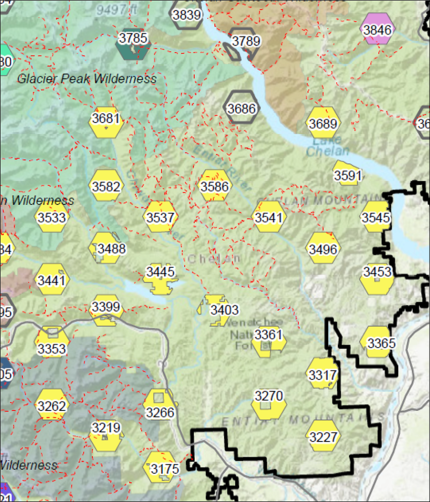
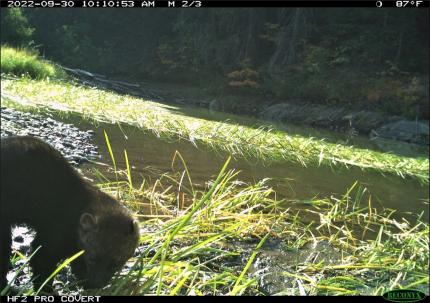
Watchable Wildlife: As the hot summer months come to an end and fall approaches, now is a good time to see snakes while out hiking or in your own backyard. Washington is home to more than a dozen snake species, only one of which is capable of harming humans with a venomous bite (but very rarely does as it strongly prefers to avoid humans) – the northern Pacific rattlesnake (Crotalus oreganus). All other snakes you may come across here are harmless to humans, such as the gopher snake (Pituophis catenifer) and northern rubber boa (Charina bottae), both pictured below. With the onset of cooler weather and shorter days, snakes are on the move and getting ready to make their way back to overwintering areas (hibernacula) in sheltered places such as underground burrows or rock piles where they remain largely inactive for six or seven months before emerging again in the spring. All snakes in Washington eat rodents (among other things) and thus are important allies in pest control, keeping the populations of rats and mice down. Please let these beautiful and beneficial creatures live their lives and respect their right to coexist peacefully alongside us.
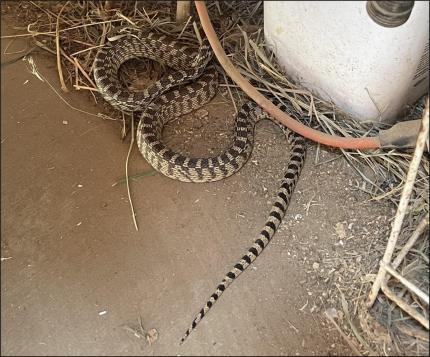
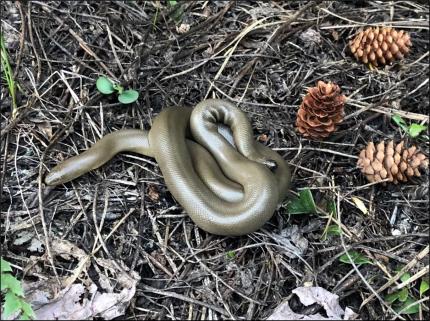
Northern Leopard Frogs: Biologist Morris helped Leopard Frog Biologist Nason with checking leopard frog enclosures, measuring tadpoles and frogs, and releasing sufficiently mature frogs. The northern leopard frog is classified as endangered by the state of Washington. Recovery efforts include breeding and releasing the frogs to try and increase population numbers in the Columbia Basin.
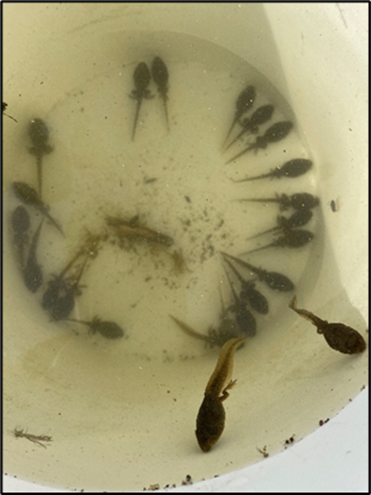

Providing Recreation Opportunities
Hunter Access Contract Renewals: Biologist Cook worked on contacting around 20 landowners to renew Hunter Access contracts that are set to expire this year. Most landowners quickly wanted to renew contracts and a few wanted to remove their property from the Hunter Access program. Cook will continue to contact landowners and begin entering the contract information for contract creation.
Hunter Access: Big game hunters are beginning to plan for the fall hunting season, and Biologist Morris helped several hunters with their planning by providing information about private lands and public land hunting opportunities within their units.
Hunter Access: Private Lands Biologist Braaten began working with cooperating landowners getting permission slips and signage ready for hunting seasons in Douglas and Grant counties.
Hunter Access for Youth Hunters: Private Lands Biologist Braaten was contacted by wildlife area staff members regarding a hunter access opportunity near Loomis for youth deer. Permission was given to provide landowner contact info.
Beebe Springs: In early August, wildlife area staff members worked on repairing pond levelers at Beebe Springs Wildlife Area. These pond levelers are designed to drain water from the beaver pond without affecting the beavers. The repaired pond levelers had been pushed around and were no longer flowing. Hopefully with the repairs to the pond levelers the trail will flood less often.
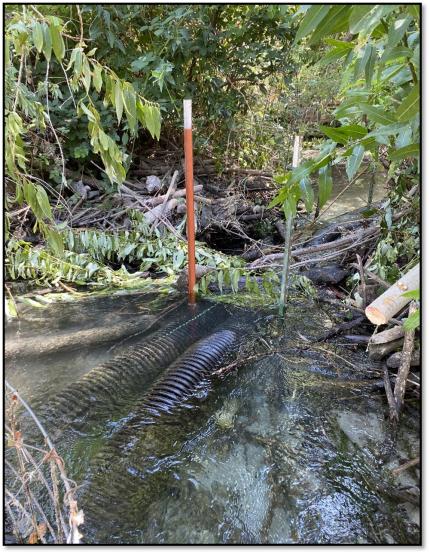
In Swakane Canyon, the irrigation line that supplies water to the shrub plots broke in several places due to an increase in water pressure from a repair further up the line, staff members spent several weeks patching the line and making improvements.
Staff members took advantage of the hottest parts of the summer to catch up on training, and plan for the upcoming year. They also started to monitor amphibians and inventory species found on the wildlife area, which will be a focus going forward. Pearson’s Pond in Swakane Canyon was surveyed and long toed salamanders and Pacific chorus frogs were found.
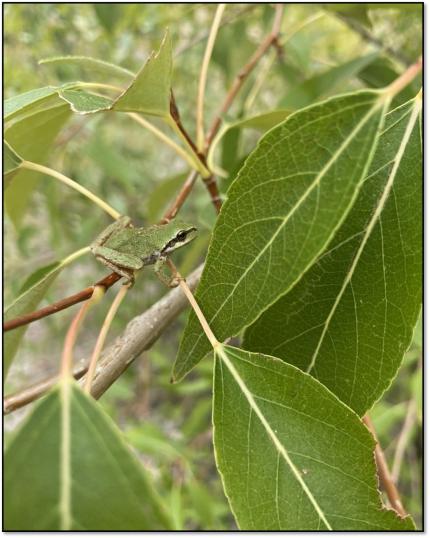
Water Access Manager Harmon and Assistant Manager Steele and Columbia Basin Wildlife Area staff members started a heavy-duty swing gate installation at the entrance to the Seep Lakes east of the Potholes Reservoir.
Manager Harmon and Steele also checked the progress of a boat launch bank stabilization effort at the Glenn Williams access site on the Potholes Reservoir.
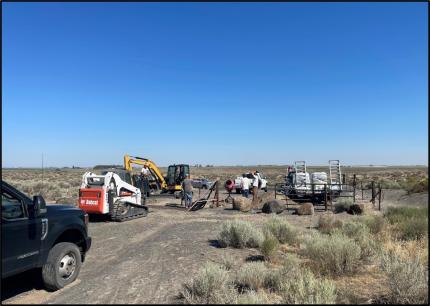
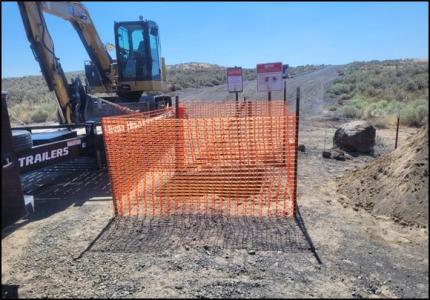
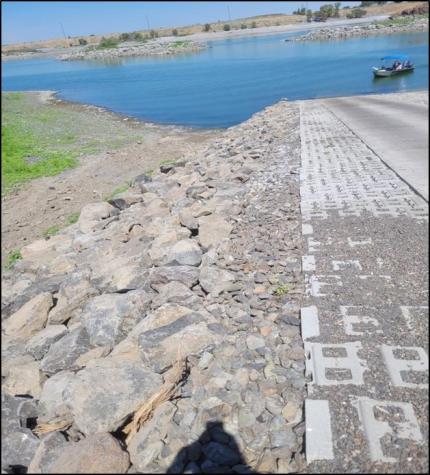
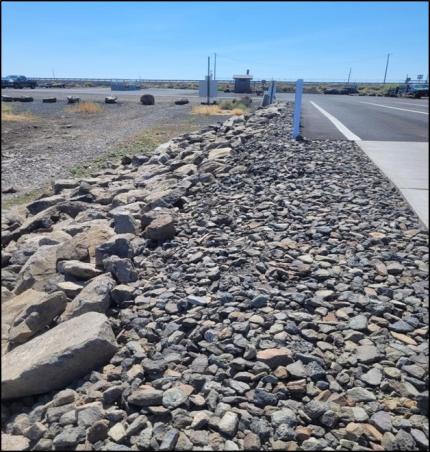
Providing Conflict Prevention and Education
Road 14 Encampment: Wildlife area staff members found an area off Road 14 where people had driven off an established parking lot through uplands and set up an encampment. Wildlife area staff members coordinated with Enforcement Program who gave occupants a notice to vacate the area.
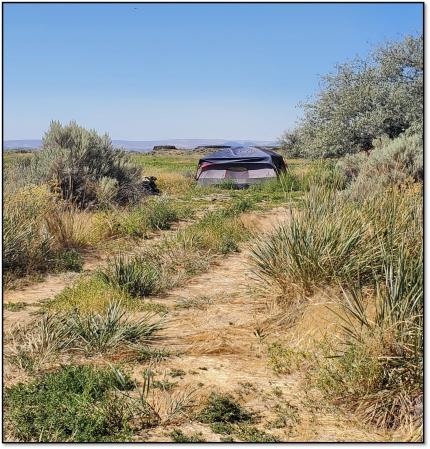
Seep Lakes Gate Installation: Wildlife area, access, and archaeologist staff members started the gate installation going into the Seep Lakes. Both holes for the swing gate and lock post were excavated while archeologist observed, and the swing gate side was poured. Once swing gate concrete sets, wildlife area and access staff members will pour the lock box post.
Spud Field Abandoned Car: Biologist McPherson and Specialist Walker located an abandoned vehicle off road that goes to spud field. Wildlife area staff members reported the incident to the Enforcement Program who will investigate the matter. Once the investigation is complete, the wildlife area staff members will have to remove the car and begin the process of trying to dispose of the car at a local junkyard.
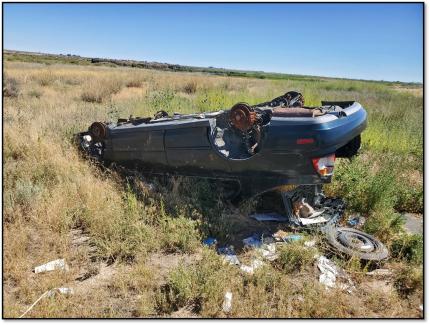
Range Rider Payment Processing: Specialist Heilhecker submitted an order payment form, invoice, and activity logs to fiscal staff members for range rider payment. The paperwork is required to pay a livestock producer for range riding under a Damage Prevention Cooperative Agreement.
Responding to Bear Report: Specialist Heilhecker responded to an email about a bear at Leader Lake. The email did not include an address or phone number. She gave the reporting party her contact number and asked them to call. The reporting party has not called.
Elk Fence Inquiry: Specialist Heilhecker received a call from an orchardist who wanted fencing material. A WDFW employee had incorrectly told the orchardist he was eligible because he lived in an elk area. Specialist Heilhecker explained the limited budget requires prioritizing landowners with damage and those who have had damage prevention cooperative agreements with WDFW in the past. She also explained the cost-share fencing program along with the new requirement of a cultural resource assessment on the property.
Conserving Natural Landscapes
Douglas County Habitat Project: Private Lands Biologist Braaten worked on plans to assist a private landowner this fall with an EQUIP project in East Foster Creek Riparian Habitat Restoration Project. This will include assistance to plant 1600 plants and provide 14 rolls of fabric mulch.
Douglas County Habitat Project Jacobsen: Private Lands Biologist Braaten working with landowner to possibly assist plant sage brush within Conservation Reserve Program (CRP) that was burnt in Road Eleven Fire in 2020. Approximately 7500 plants need to be planted.
Incidental Wildlife Observations: Biologist Morris observed some fun wildlife this month, including upland game birds, deer, waterfowl, and non-game wildlife.
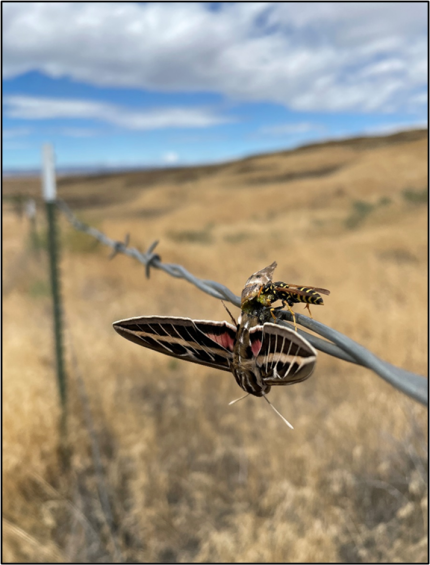
Supplemental Food Plot Maintenance: Biologist Cook and Technician Blanchard borrowed a MT-100 and mower attachment from the water access crew in Region 2 South. This equipment was smaller and more maneuverable than the private lands tractor and mower and able to better mow the needed areas. Blanchard and Cook mowed weed patches on the edges and ends of the food plot to reduce the seed production and spread of weeds in future years.
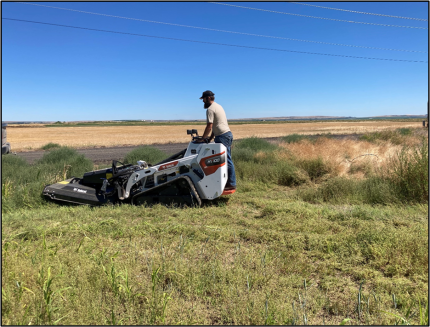
Providing Education and Outreach
Vegetation Monitoring and Mapping Drone Survey Press Release: Biologist McPherson coordinated with Communication Consultant Lehman about what would be needed for a press release about drone missions on the wildlife area. Due to the areas where drone flights will occur, they agreed that a notice on the wildlife area website would be sufficient for the activity.
Master Hunter Discussion: Specialist Heilhecker received a call from the Master Hunter Advisory Group representative for Region 2. They discussed how and when master hunters have been used in Okanogan County and options for master hunters to earn volunteer hours.
Hunter Outreach: Private Lands Biologist Braaten called back many hunters wanting information about private lands access, hunting permits, and general hunting questions.
Conducting Business Operations and Policy
Wolf Advisory Group: Specialist Heilhecker met with the Wolf Advisory Group (WAG) facilitator to discuss the direction of WAG.
Annual Fire Extinguisher Inspection: Biologist McPherson scheduled an annual fire extinguisher inspection with Performance Systems Integration (PSI). PSI came to headquarters and serviced all the fire extinguishers for our facility and associated equipment.
Other
Wolf Advisory Group: Specialist Heilhecker met with the Wolf Advisory Group (WAG) facilitator to discuss the direction of WAG.
Annual Fire Extinguisher Inspection: Biologist McPherson scheduled an annual fire extinguisher inspection with Performance Systems Integration (PSI). PSI came to headquarters and serviced all the fire extinguishers for our facility and associated equipment.